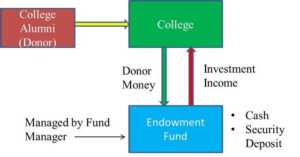Most of the educational institutes find it difficult to generate funds for their overall growth. The dependency of institutes on government funding has led to a slow pace of growth and created a barrier in understanding the sense of responsibility of every individual towards their own educational institutes.
For the institutes to support their students, pursue the very best faculty, adopt new technologies, and try to keep pace with the expansion of knowledge, these institutions need additional resources if they are to serve their public purposes effectively and remain world leaders in their fields. Also with the costs of high-quality education and research growing rapidly, the academic institutes need to expand their financial aid programs.
Most of the successful universities have a large size of endowment funds. King Abdulla University of Science and Technology has an Endowment fund of more than 20 billion US dollars, the National University of Singapore has a fund of 3.75 billion US dollars, Koyata and Osaka University has an endowment fund of more than 2 billion US dollars and there are several other western universities and colleges with a large amount of endowment fund. So the largest endowment funds in the world are held by Educational Institutes (esp. Universities).
An endowment fund is a financial asset, typically held by a non-profit organization, which contains the capital investments and related earnings leveraged by the non-profit organization to fund the overall mission.
Endowment funds are typically structured by strict contractual obligations and rules to be followed by the non-profit organization, the primary purpose of the fund is to ensure the long-term financial health of the non-profit organization and its beneficiaries.
Here generous and wealthy alumni donate money to the educational institutes each year. The financial donations accumulate in the fund as the principal balance, and certified fund managers ensure the principal balance of all donations are invested into a variety of different investment options that are typically restricted by the investment policy of the endowment.
Example: An institute receives the donations or was able to generate the principle balance fund of Rs. 1 Cr and the policy of the fund states that the institute cannot leverage the principle amount to fund its regular operations. However, during the year the fund manager was capable of generating the interest or dividend earnings of Rs. 2 lakhs by investing the principle amount in various avenues available in the market. Then this amount of Rs. 2 lakhs can be used as an endowment fund to facilitate its own growth engine in terms of funding research and innovation, support student financial aid, teaching, infrastructure development and various social services.

Endowment funds consist of cash, equities, bonds, and other types of securities that can generate investment income.
The major difference between an endowment fund and a typical investment fund – such as a mutual fund – is that the beneficiary of an endowment fund is a non-profit organization instead of individual investors. Typically, the principal value of an endowment fund is kept intact, while the investment income can be used for certain purposes.
Thus, an endowment fund can be held permanently. Also, alumni can restrict the use of endowment funds for specific purposes. For example, alumni can provide the donation capital to exclusively fund research and the institute has to us it for the same purpose only.
An educational institute can develop four types of endowment funds.
Term endowment: These funds are reserved and not available for the daily use of the organizations. However, an institute can use this fund completely or partially depending upon the circumstances after a certain time period defined by the organization.
Restricted Endowment: This fund can only be used for certain purposes determined by the donor.
Unrestricted Endowment: The donor of an unrestricted endowment fund does not limit the purpose of the usage. The recipient is allowed to spend the money for defined purposes.
Quasi-Endowment: A quasi-endowment fund is not required by any legal restriction to exist permanently, which means the principal of a quasi-endowment is allowed to be spent at some point. Usage and withdrawal restrictions may exist in a quasi-endowment fund, but the board can end the restrictions for any reason and use the money for any purpose at any time.
An established concept in premier western universities, endowment funds only made a debut in India last year with IIT-Delhi. The Indian Institutes of Technology (IIT), the Indian Institutes of Management (IIM), the National Institutes of Technology (NIT) and all technical institutions run by the central government will now have individual endowment funds.
The Ministry of Human Resource Development has given its go-ahead to a policy under which all centrally-funded technical institutions (CFTI) will create the fund.
The guidelines created by MHRD state that the fund will be governed by a board, which will be able to take all major decisions regarding expenses. The board will be chaired by the director of the institute, while other members will include professors and prominent alumni-donors. The guidelines clearly state that only earnings from them can be spent. The governing body can decide on how the fund will be managed and also decide if the institute needs to open a new company/trust for managing the funds. The HRD ministry guidelines also state that each institute will fix an aspirational value to the amount of corpus fund, which will be mobilized on the basis of alumni strength and an average salary of each alumnus, and possibly from philanthropy, among other sources.
An endowment links past, current and future generations. It allows an institution to make commitments far into the future, knowing that resources to meet those commitments will continue to be available. Endowment funds serve institutions by providing stability, leveraging other sources of revenue, encouraging innovation and flexibility and allowing a longer time horizon.
So it’s high time for Indian educational institutes to start working on endowment funds so that they can sustain comfortably in the near future.



